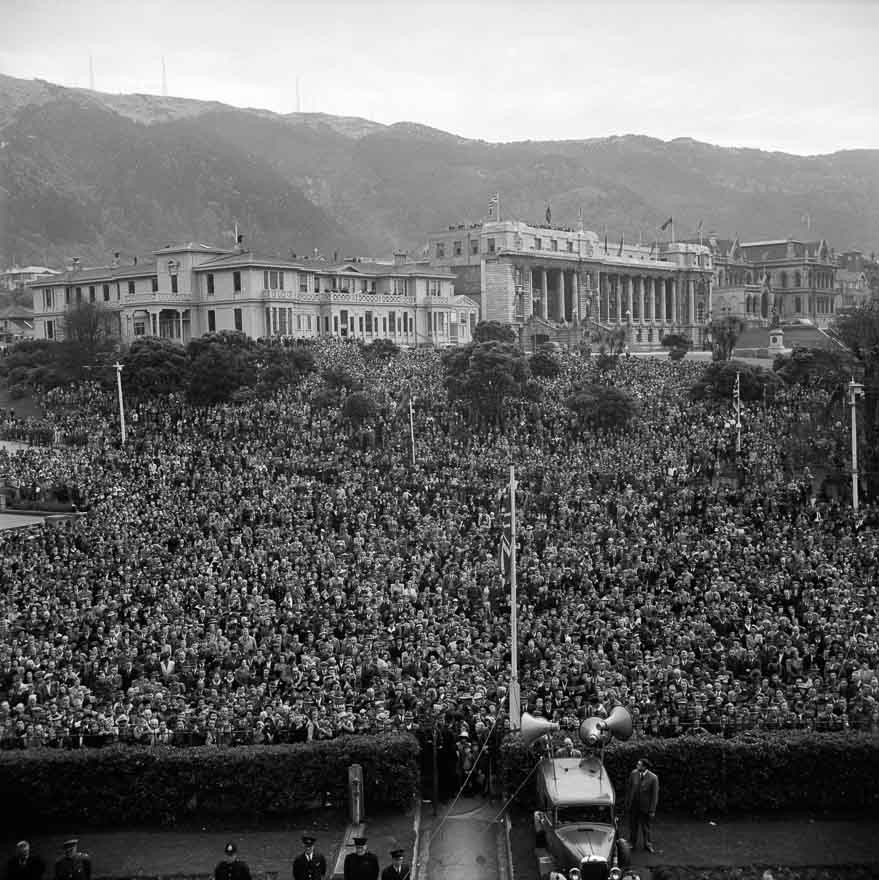A Period of Change (1870 - 1950)
Day 5 - Coming to an end
Activity 1 | VE Day!
 After six long years of fighting, World War II finally came to an end in 1945. The entire country was ecstatic and parties were thrown all over New Zealand to celebrate VE Day (Victory in Europe). Imagine that you were living in New Zealand in 1945 and you had to plan a VE day party at your house. Who would you invite? What would you do to celebrate?
After six long years of fighting, World War II finally came to an end in 1945. The entire country was ecstatic and parties were thrown all over New Zealand to celebrate VE Day (Victory in Europe). Imagine that you were living in New Zealand in 1945 and you had to plan a VE day party at your house. Who would you invite? What would you do to celebrate?
On your blog, tell us all about your (imaginary) VE party. If it was me, I would invite all of my closest friends and family over to my house for a big barbecue. We would eat hamburgers and play basketball in the driveway. Some of us would probably walk to the local beach to play soccer on the beach and to go for a swim (if the weather was warm enough)!
I would invite my friends and family.
I would play games like cricket or soccer.
I would invite my friends and family.
I would play games like cricket or soccer.
Activity 2 | Making a Fashion Statement
In the years following World War II, things slowly returned to normal in New Zealand. Soldiers returned home and settled back into regular life; and national sporting teams, like the New Zealand cricket team, got back together and started playing matches again. In the late 1940s, men and women would go to watch these events, men wearing hats and suits and women wearing dresses, hats, and gloves.
Compare the pictures of common clothing from the late 1940s to what you wear now (i.e. in 2017). Are they similar or are they quite different?
On your blog tell us which of the two styles you prefer and why. The pictures above were taken over 65 years ago! What do you think people will be wearing 65 years from now?
I would prefer the latest version because it looks a bit good than the old version.
I would prefer the latest version because it looks a bit good than the old version.
Bonus Activity | Sweet Tooth
When World War II ended, a number of people from Europe moved to New Zealand looking for a peaceful place to live and raise a family. When they came, they brought recipes and foods from their native countries with them, including hamburgers, pizza and other delicious foods.
I usually have a chocolate chip cookie with my tea. I love biscuits! What is your favourite sweet treat or dessert? Use google to find a recipe for it. Type the recipe out on your blog. Make sure you also include a picture.
Ingredients
For Dough
- 2 Cup All Purpose Flour/Maida
- ¼ tsp Baking Powder
- ¼ tsp Vanilla Extract
- 2-3 Pinch of Salt
- 3-4 tbsp Melted Butter
- 1 Packet Dry Active Yeast (2¼tsp)
- 3-4 tbsp Sugar
- ½ cup Milk
For Glazed/Coating
- ½ Cup Powder Sugar
- 2-3 tbsp Melted Butter
- 2-3 tbsp Warm Water
Topping
- Chocolate Dip (Dark n White)
- Coloring sprinkles
- Chopped Dry fruits (pistachios or almonds)
Extra flour for Dusting/Rolling
Oil for Deep Frying
Instructions
- Take a small bowl. Add warm milk, sugar and mix well till dissolve completely. Add dry yeast, mix it, cover it and keep aside for 10 minutes or till yeast will become foamy.
- Take a big bowl and shift the flour in it. Add salt, baking powder and mix well. Add melted butter, vanilla extract, yeast mixture and mix well.
- Now make little sticky dough, use water if required.
- Dust the flour on the kitchen surface and turn the dough on it, then knead it for 5 minutes or till smooth soft dough.
- Cover the dough in the same bowl for 30-35 minutes till double.
- Once dough will become double, punch it down, knead it again for 2 minutes, and divide into 2-3 portion balls.
- Dust the flour and roll the ball into thick circle.
- Now use a round cookie cutter or a sharp corner round glass and cut into small-small disk. Take a small cap/lid of small bottle, press on center of disk and make small hole. You will get exact shape of donut.
- Place the donuts on tray. Apply little oil with brush or spray. Cover the tray with plastic wrap and keep aside for 25-30 minutes or till double.
- Heat oil in a deep pan, fry the donuts on a medium flame till golden brown, remove it on absorbent paper and keep aside.
- If you don’t want to fry them, you can bake them 200 C or 450 F for 5-7 minutes till golden brown.
- Take a small bowl for sugar glaze. Add powder sugar, melted butter, warm water, mix it well and make syrup.
- Dip the fried donuts in the sugar syrup and coat them all side.
- You can dip into a chocolate dip as per your choice and sprinkle with different kinds of toppings like dry fruits, coloring sprinkles, etc…
